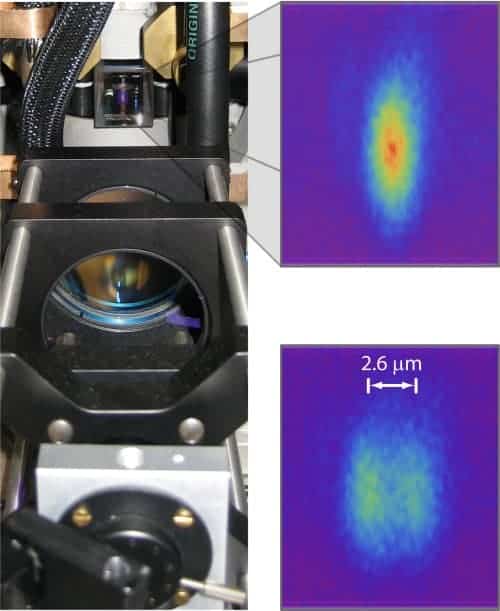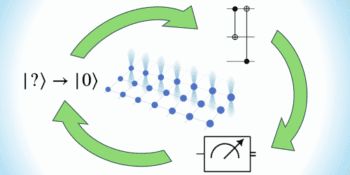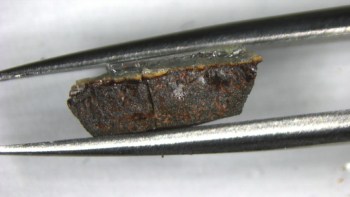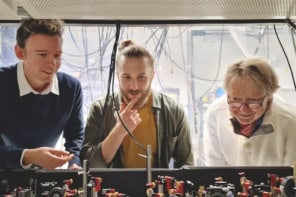
Single atoms have been spotted doing the quantum version of the random walk by physicists in Germany. This sighting of a “quantum walk” could help in the design of quantum search algorithms, or in the understanding of the transition from the quantum, microscopic world to the classical, macroscopic world.
The random walk is a simple concept that has been used to describe many real-world systems from stock market prices to the Brownian motion of tiny particles floating on a liquid. It is usually described as a person who dictates his movements by the toss of a coin: get heads, for example, and he moves one step to the right; get tails and he takes a step to the left. After many coin tosses, the person’s position is random, but is most likely to be close to the start point.
The quantum walk was first proposed by Nobel laureate Richard Feynman and is almost the opposite of its classical cousin. After every toss, a quantum particle moves in both directions simultaneously, and adopts a “coherent superposition” of right and left. After many steps, the particle becomes blurred or “delocalized” over many different positions. However, the nature of this process means that, after more than one toss, the new superposition will overlap part of the old one, and will have the effect of either amplifying or removing that position. This is known as matter-wave interference, and means that the eventual position of the particle is most likely to be farthest away from the starting point.
True to Feynman’s proposal
Several groups have created systems that exhibit a form of quantum walk in the past, including the tunnelling of light through waveguides and the phase-space movement of trapped ions. But now Artur Widera and colleagues at the Institute for Applied Physics at the University of Bonn have realized Feynman’s original proposal — the quantum walk of a single particle with controllable states.
In their experiment, the researchers trap a single, cold caesium atom in two optical lattices that initially overlap (see figure). They begin using a laser pulse to prepare the atom in a superposition of two internal states. Next, they move the lattices in opposite directions, which makes the atom simultaneously “step” both to the right and left. When they repeat this manoeuvre, the superposition stretches over another step, but the position in the middle then contains two parts of the atom that interfere with each other.
After ten steps, the Bonn group used a high-resolution microscope to detect the fluorescence emitted by the atom, and thus cause it to settle in one position. The probability distribution of final positions built up from many experiments was anti-symmetric about the start point, which agreed with a computer model of a quantum walk. However, if the researchers destroyed the superposition at every step, the distribution reverted to the classical case — in other words, a binomial with the peak around the start point.
‘Groundbreaking results’
Tobias Schaetz, a researcher at the Max Planck Institute for Quantum Physics, also in Germany, who has previously performed studies into quantum walks, thinks the Bonn group’s results are “groundbreaking” because of the technical improvements required to access the effects of spatially delocalized atoms, and because they will help in the understanding of quantum effects in macroscopic systems.
The next step will be perhaps to implement a quantum-walk based algorithm Yaron Silberberg and Yoav Lahini, Weizmann Institute of Science
Yaron Silberberg and Yoav Lahini, who are both at Weizmann Institute of Science in Israel and who both study quantum walks, also praise the level of control demonstrated by the Bonn group. “Most importantly, this technique may enable a practical implementation of the quantum walk approach to quantum information science,” they write in an e-mail. “The next step will be perhaps to implement a quantum-walk based algorithm.”
Widera says that his group’s experiment is a proof of principle of such a quantum-walk algorithm. Moreover, he explains that it might help in the understanding of certain biological processes such as photosynthesis, which is often thought to have its high efficiency rooted in quantum mechanics. “Biomolecules are much too complicated to study this in detail,” he adds. “Our system, on the other hand, allows full control of all parameters, and could help to see if quantum walks can support such a highly efficient transport mechanism.”
This research appears in the latest edition of Science.





